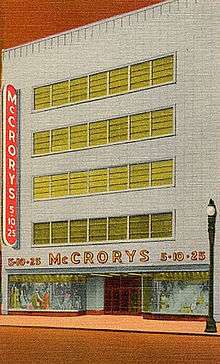McCrory Stores
McCrory Stores or J.G. McCrory's was a chain of five and dime stores in the United States based in York, Pennsylvania. The stores typically sold shoes, clothing, housewares, fabrics, penny candy, toys, cosmetics, and often included a lunch counter or snack bar. They also exclusively sold Oriole Records, one of the most popular 'dime store labels' from 1921 to 1938.
Founding
John Graham McCrorey opened his first store in Scottdale, Pennsylvania, in 1882.[1] By 1885, the chain had five stores in Pennsylvania. McCrory was known for his thrifty nature, so much so that he legally dropped the e from his last name so he would not have to pay for extra letters on his store signs.[1]
McCrory died in 1923 having built McCrory Stores Corporation into a success. However, in 1933 the company declared bankruptcy and was dissolved, but it was eventually re-established as McCrory Stores and resumed operations. One of the early investors was Sebastian Spering Kresge, who later founded the S.S. Kresge chain, which became Kmart. In 1899, Kresge traded his interest in the McCrory's Memphis, Tennessee store for McCrory's interest in the Detroit, Michigan, store, giving him control there. In 1987, the Kmart Corporation sold its remaining Kresge and Jupiter stores in the United States to McCrory Stores.[1]
History

At its height, McCrory's operated 1,300 stores under its own name and as TG&Y, McLellan (merged in 1958), H. L. Green, Silvers, G.C. Murphy, J.J. Newberry and Otasco,[2] which it had acquired through the years. McCrory's parent Rapid-American also owned Lerner Stores and National Shirt (acquired by McCrory's in 1960).
Meshulam Riklis purchased McCrory's in 1960, and moved its headquarters to Springettsbury Township, York County, Pennsylvania, in 1963. At the time it was the fourth largest retailer in the United States. Riklis controlled McCrory's through the Rapid-American holding company, which was managed by Samuel Neaman. Riklis' famed sleight of hand, shifting assets between notable brand name successful companies and holding companies is best exemplified by his handling of McCrory Stores, driving the brand name into bankruptcy while keeping the assets.[3] Among the retailers controlled by McCrory's at the time were Best & Co., Lerner Shops, and S. Klein.
In 1986 it purchased the 76 remaining Kresge and Jupiter stores from Kmart, reuniting the companies. It was at this time controlled by E-II Holdings, Inc., which also owned Elmore, Britts, and Kittinger and Bargain Time. E-II Holdings was a group of jilted Riklis investors, seizing old Riklis properties trying to recoup their losses.
Decline
In 1989, 1,300 stores were operated by the McCrory company. However, as the decade turned, its fortunes decreased, and by 1992 it filed for bankruptcy. Several rounds of store closures followed, with one of the biggest coming in 1997 when McCrory's shuttered 300 of its last 460 stores. The company also converted some stores to their Dollar Zone format of dollar store, but these closed in early 2002.[4] In December 2001, McCrory Stores announced the remaining McCrory's,[4] TG&Y, G. C. Murphy and J.J. Newberry stores it was operating would begin liquidating and in February 2002 the company ceased operation.[5]
References
- 1 2 3 "A Kresge-McCrory Reunion". New York Times. April 4, 1887. Retrieved 2010-12-14.
Mr. McCrory preceded Mr. Kresge in the industry, opening his first store in Scottdale, Pa., in 1882. Three years later, he was operating five stores in the state. Born John Graham McCrorey, he was so thrifty he legally changed his name, dropping the e, because he did not want to pay the cost of the extra initial in the gilt letters on his store signs. ...
- ↑ O'Dell, Larry. "OTASCO". Encyclopedia of Oklahoma History and History. Oklahoma State University Library. Archived from the original on November 19, 2012. Retrieved January 4, 2017.
- ↑ "Riklis Family Corp". FundingUniverse.com. Archived from the original on November 16, 2007.
- 1 2 "Local Dollar Zone stores shuttered". Dayton Business Journal. December 19, 2001. Retrieved 2009-06-03.
- ↑ "Say goodbye to TG&Y". The Journal Record. Oklahoma City. December 3, 2001.
- Isadore Barmash (1976). For the Good of the Company: The History of the McCrory Corporation. ISBN 1-58798-215-3.